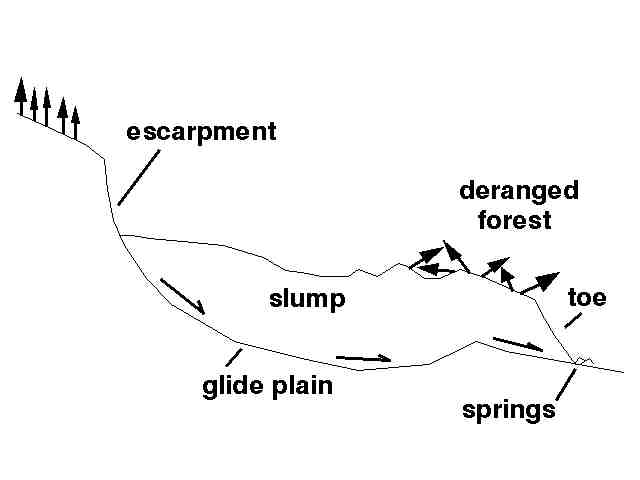CHAPTER 8 - MASS WASTING
MASS WASTING: the downslope movement of rock, regolith, and soil
under the direct influence of GRAVITY.
- occurs practically anywhere in hill or mountainous terrane.
- often violent, causes on immense disasters.
- needs a trigger (ice melt, change in groundwater, earthquake)
ANGLE OF REPOSE: the steepest slope materials can maintain (may
be different if wet or dry) 25-40 degrees.
- mud: very low angle (approaches water)
- sand and gravel: intermediate
- boulders: forms a steep talus slope
- rock: forms a cliff
TALUS SLOPE - accumulation of rock debris at the base of a cliff.
CLASSIFICATION OF MASS WASTING PROCESSES
Movement occurs downslope along defined surfaces; the type of
slope, the kind of material (rock, cinders, mud, etc), and the
amount of water (or ice) involved result in different forms:
- ROCK SLIDE - usually along breaks along bedding planes on
steep cliffs or road cuts. Sometimes called a Rock Avalanches.
(Avalanches, in the true sense, must involve snow and ice, rock
slides don't necessarily need ice.) Rock slides happen very
rapidly and can be quite destructive.
- SLUMP - along a "slick fracture" in the subsurface. Slumps
typically occur in water-saturated mud or shale. Slumps generally
move very slowly, and are especially destructive to man-made
structures. (The weight of a new building can trigger a slump!)

Slumps commonly form on steep slopes where either water erosion
or human activity, or flooding by a reservoir causes water to
seep into crevases, usually move after a rain. Springs along the
"toe" of a slump are a clue. Also, forests that have trees
bending or leaning in many directions are a clue that a slump is
affecting an area.
- Types of Movement downslope as a VISCOUS FLUID
- MUDFLOWS - saturated mud cuts loose after a rainstorm. Flow
is very rapid - mostly mud and debris flowing down a valley and
spreads out on a plain at the base. If there is more water than
mud it is considered a FLASHFLOOD!
- FLASHFLOOD - muddy, debris-laden water which occurs after a
heavy rain when rainwater runs off an gathers in gullies. The
more water, the faster it flows. The deeper, faster-moving water
"piles up" and rushes down stream as a wave front, followed by a
deeper surge. Flash floods can travel great distances for many
hours, even long after a storm cloud has vanished. They are VERY
DANGEROUS, especially to traffic in flashflood prone desert
regions.
LAHAR - a mudflow as a result of a volcanic eruption.
Composite volcanos (such as anywhere around the Pacific "Ring of
Fire") are poorly consolidated, wet and icey at their high
summits. Volcanos in wet climates are prone to these type of
flows; they have been known to kills thousands...
- EARTHFLOW - saturated mud flows plastically downslope,
generally small and only abundant in areas where there is
abundant water or melting ice: ("Goopier than an slump".)
CREEP: the slow movement downslope due to repeated expansion and
contraction of the surface (mostly ice, wetting and drying). The
soil-covered slope of a hillside very slowly moves downslope to a
creekbed at the bottom of a hill. Creep can cause soil to pile
up against the side of a house, breaking its foundation. Trees
that are bent at their base are an indication of creep.
PERMAFROST: - zone of frozen soil in arctic regions and mountain
tops. (Soil often directly overlies ice.) Building is a problem
in areas of permafrost, because the heat of a house or a black
road surface (heated by the sun) can cause permafrost to melt
(i.e. sinking houses).
SOLIFLUCTION - mass movement due to meltion of permafrost.
Click here to return to the CLASS Web
Page.
